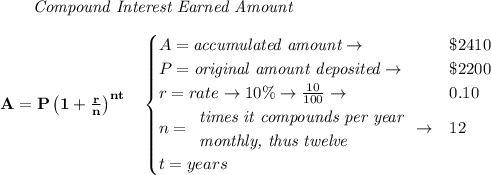
Mathematics, 16.07.2019 10:50 brandonholden
Use a=p(1+rn)nt a=p(1+rn)nt where: a = the amortized amount (total loan/investment amount over the life of the loan/investment) p = the initial amount of the loan/investment r = the annual rate of interest n = the number of times interest is compounded each year t = the time in years find how long it takes a $2,200.00 investment to earn $210.00 in interest if it is invested at 10% compounded monthly. it will take years. (round answer to 3 decimal places.)

Answers: 1
Another question on Mathematics

Mathematics, 21.06.2019 16:30
What is the area of a pizza with a radius of 40 cm leave the answer in terms of π to find your exact answer 40π cm² 1600π cm² 800π cm² 80π cm² π=pi
Answers: 1

Mathematics, 21.06.2019 21:30
Suppose that sahil knows that 45 people with ages of 18 to 29 voted. without using a calculator, he quickly says then 135 people with ages of 30to 49 voted. is he correct? how might sohil have come up with his answer so quickly?
Answers: 3

Mathematics, 21.06.2019 22:00
The evening newspaper is delivered at a random time between 5: 30 and 6: 30 pm. dinner is at a random time between 6: 00 and 7: 00 pm. each spinner is spun 30 times and the newspaper arrived 19 times before dinner. determine the experimental probability of the newspaper arriving before dinner.
Answers: 1

Mathematics, 21.06.2019 23:00
The equation shown below represents function f. f(x)= -2x+5 the graph shown below represents function g. which of the following statements is true? a. over the interval [2, 4], the average rate of change of f is the same as the average rate of change of g. the y-intercept of function f is less than the y-intercept of function g. b. over the interval [2, 4], the average rate of change of f is greater than the average rate of change of g. the y-intercept of function f is greater than the y-intercept of function g. c. over the interval [2, 4], the average rate of change of f is the same as the average rate of change of g. the y-intercept of function f is greater than the y-intercept of function g. d. over the interval [2, 4], the average rate of change of f is less than the average rate of change of g. the y-intercept of function f is the same as the y-intercept of function g.
Answers: 1
You know the right answer?
Use a=p(1+rn)nt a=p(1+rn)nt where: a = the amortized amount (total loan/investment amount over the...
Questions

Computers and Technology, 05.05.2020 19:45

Engineering, 05.05.2020 19:45

Mathematics, 05.05.2020 19:45



History, 05.05.2020 19:45








Mathematics, 05.05.2020 19:45




Chemistry, 05.05.2020 19:45


History, 05.05.2020 19:46


![\bf 2410=2200\left(1+\frac{0.1}{12}\right)^{12t}\implies \cfrac{2410}{2200}=\left(1+\frac{1}{120} \right)^{12t} \\\\\\ \cfrac{241}{220}=\left(\cfrac{121}{120} \right)^{12t}\implies log\left( \frac{241}{220} \right)=log\left[ \left(\frac{121}{120} \right)^{12t} \right]\\\\\\ log\left( \frac{241}{220} \right)=12t\cdot log\left(\frac{121}{120} \right)\implies \cfrac{log\left( \frac{241}{220} \right)}{12 log\left(\frac{121}{120} \right)}=t\implies 0.915 \approx t](/tpl/images/0096/0326/6c5ab.png)



